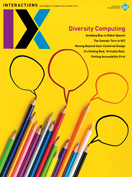Authors:
Loren Terveen, Helena Mentis, Aaron Quigley, Philippe Palanque
The ACM Conference on Human Factors in Computing Systems (CHI) was born in 1982 and has been held annually since 1985. Specialized conferences (such as IUI, CSCW, MobileHCI, and UIST) gradually emerged and have now become a significant part of the conference program that ACM SIGCHI offers the global HCI community. SIGCHI's conference portfolio has grown steadily over time, from five in 1997 to 10 in 2006, 15 in 2009, 20 in 2014, and currently 24 conferences including CHI. To date, SIGCHI has sponsored or co-sponsored 298 conferences. Along with the growth in numbers and diversity of topic areas, our conferences have steadily become more global. The first SIGCHI-sponsored conference in Europe was in 1993 (INTERCHI '93 in Amsterdam), in Asia in 1998 (VRST '98 in Taipei), in Oceania in 2006 (IUI '06 in Sydney), and in Africa in 2008 (DIS '08 in Cape Town). We have further provided in-cooperation support to 427 conferences, of which 91 have been in North America, 231 in Europe, 53 in Asia, 25 in Oceania, 19 in South America, and eight in Africa.
Not surprisingly, the number of delegates attending our events has grown too. There were 906 attendees of the first CHI conference in 1982, while 3,804 (including telepresence robots) attended CHI 2016. Today more than 9,000 delegates participate in our 24 sponsored conferences. This growth raises challenges for volunteer workload, constrains venue choices, and puts pressures on budgets.
This growth has also led to a number of changes in how SIGCHI manages its conferences. Since 2006, SIGCHI has supported the creation of a steering committee for each of our sponsored conferences. Further, the current SIGCHI Executive Committee made some changes with the aim of more sustainable and resilient processes. In the past two years, we moved from a single Conference Management Committee, with representatives of a few of our larger conferences, to creating a dedicated steering committee for the CHI conference, a Council of Steering Committee Chairs (CSCC) of all SIGCHI's sponsored conferences, and a Conferences Board that directly supports and assists SIGCHI's vice president for conferences. Crucially, these committees ensure that the diverse communities within SIGCHI have a voice in setting priorities for our conferences.
The CSCC meets annually so that all 24 SIGCHI conference steering committee leaders can share knowledge and concerns with each other and with the SIGCHI Executive Committee. This has resulted in improved support for conference accessibility; support for internationalization, diversity, and inclusion at conferences; improvements to student travel-support programs; and enhancements to SIGCHI software support and the publication process. The Conferences Board has helped with important initiatives, including deciding on some of the 19 conference development fund awards, which have supported a writing workshop, telepresence, panels, tutorials, student travel grants, broadening participation, and a summer school.
We have also recently formed a CHI conference steering committee that consists of 17 members with prior experience as CHI general chairs, technical program chairs, papers chairs, accessibility experts, and ACM operations. The steering committee members represent a diverse range of research topics and methods within our field. One important task the steering committee has taken on is to define a strategic plan for CHI conference locations, leading to a more predictable international rotation. Our five-year plan—which went into effect with CHI 2017—-calls for two conferences in North America, one in Europe, one in Asia, and one at a wildcard location that will be selected to serve strategic goals to grow the field of HCI.
We are confident that the changes we described here will help our family of conferences, including CHI, to better respond to the challenges and opportunities ahead.
The CHI conference continues to evolve in response to community interests, new developments, and strategic initiatives. For example, recent CHI conferences have pioneered an increased emphasis on diversity and inclusion, offered courses to support members in communicating with the public, and created public outreach talks. The conferences have featured many community development events, supporting participation by members of our community from the Global South, offering career guidance and networking opportunities for early career HCI researchers and practitioners, and creating mentoring and cohort-building opportunities for underrepresented groups.
By the time you read this, our current terms as SIGCHI leaders will have come to an end. However, we are confident that the changes we described here will help our family of conferences, including CHI, to better respond to the challenges and opportunities ahead for the field of human-computer interaction. We have tried to foster an open conversation between SIGCHI leadership and the entire SIGCHI community, and we encourage you to continue this with the new leadership. A good place to start is to follow SIGCHI on Twitter at @sigchi.
Loren Terveen, Loren Terveen ACM SIGCHI President, 2015–2018, [email protected]
Helena Mentis ACM SIGCHI Executive Vice President, 2015–2018, [email protected]
Aaron Quigley ACM SIGCHI Vice President for Conferences, 2016–2018, [email protected]
Philippe Palanque ACM SIGCHI Adjunct Chairforthe CHI Conference, 2016–2018, [email protected]
Copyright held by authors
The Digital Library is published by the Association for Computing Machinery. Copyright © 2018 ACM, Inc.








Post Comment
No Comments Found